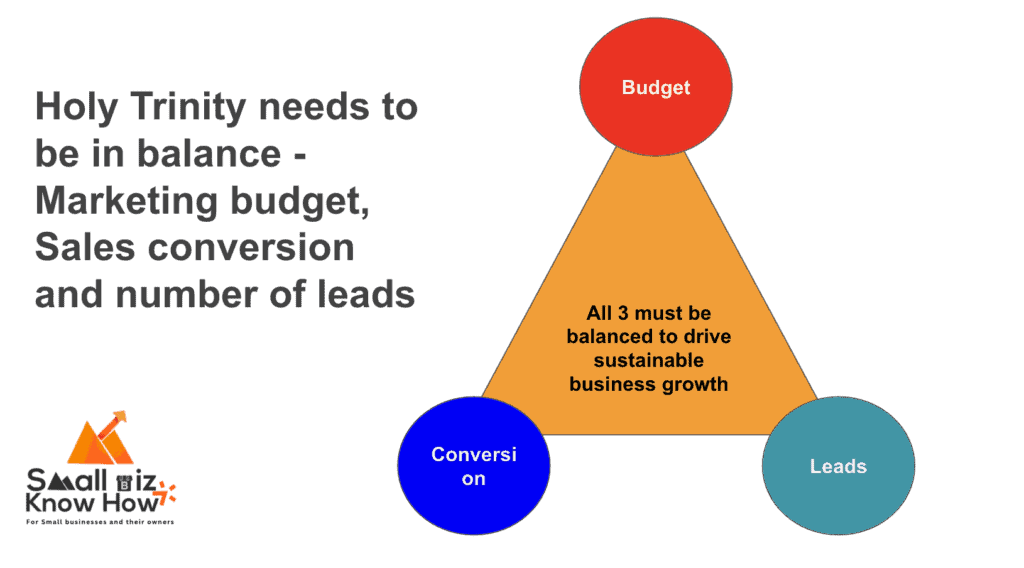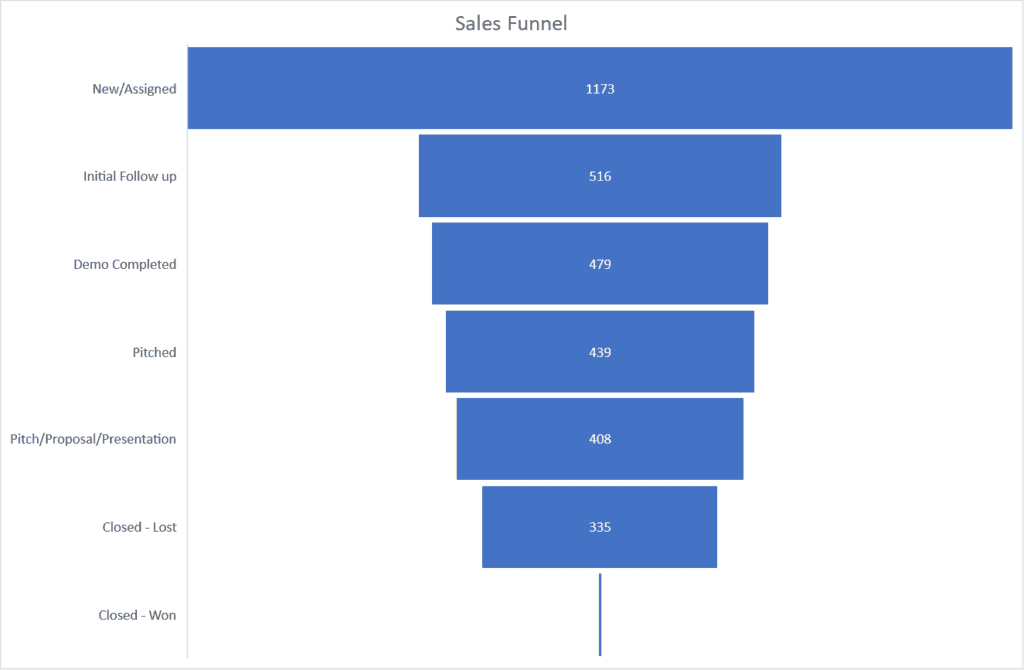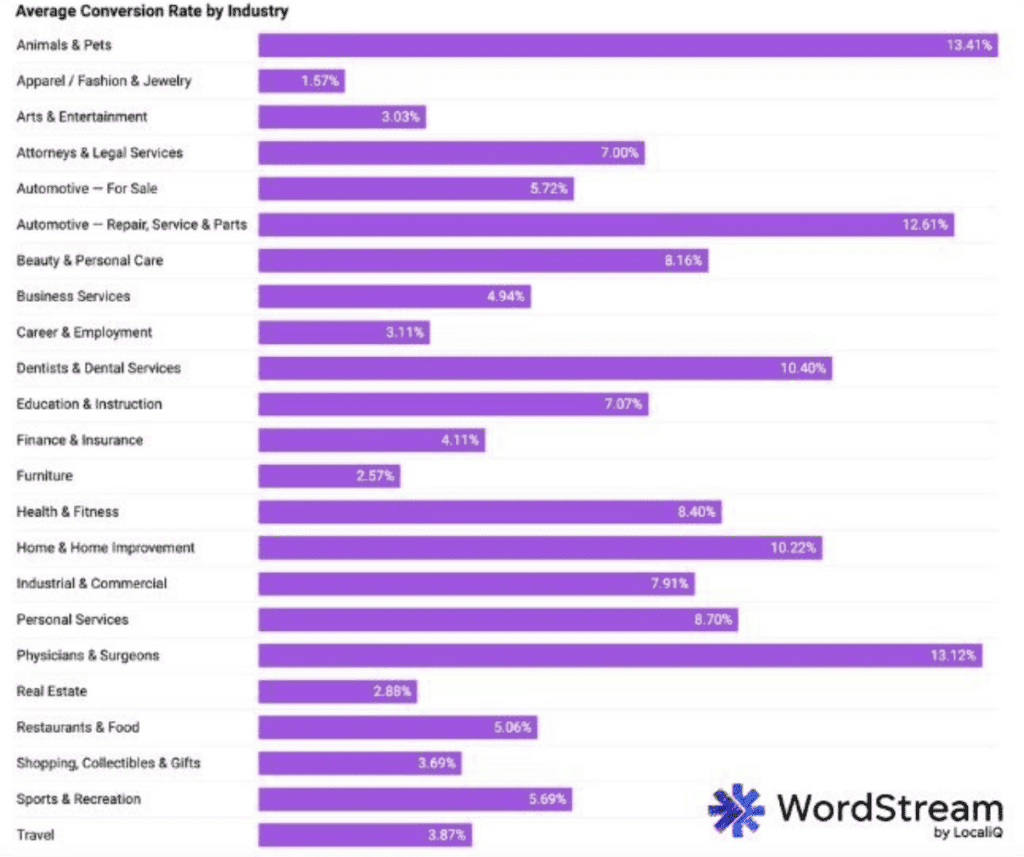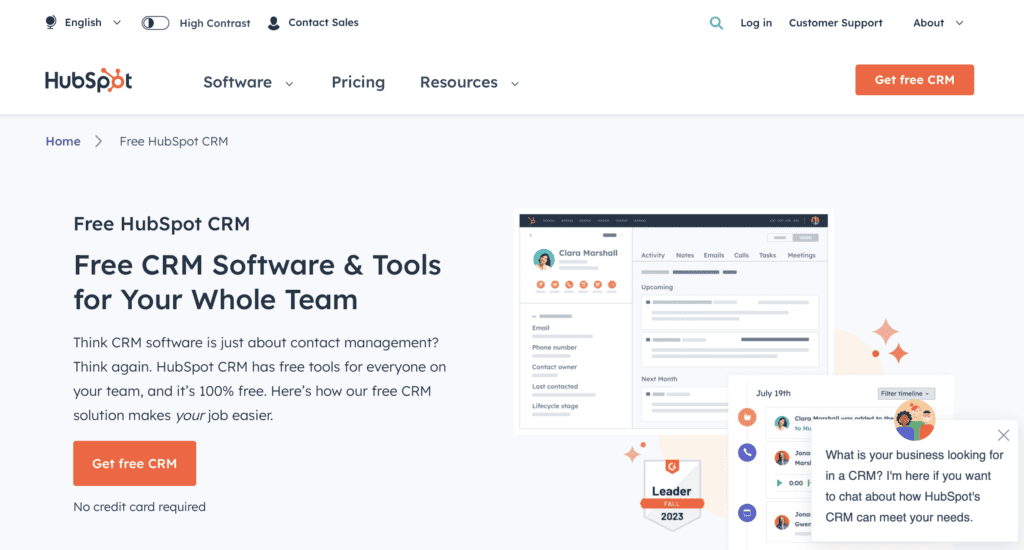During my experience as a sales operations leader in large multinationals for over 5 years in the last decade the topic of improving sales conversions rates has been a daily conversation between my team and me.
Improving sales conversions is one of the pillar strategies to grow sales for a small business.
Sales conversions have often been spoken about in a digital marketing frame of reference, where a business drives a bunch of traffic and a small portion of that traffic turns into paid customers. But in this article, I will break it down to a fundamental level, go into all the components of what influences sales conversions so that even an offline business will find value.
To start this off lets begin at the basics. The basic requirement for a small business to understand how to improvements is to start at the sales and marketing funnel.
Sales and marketing conversions: Learning the basics of the sales and marketing funnel to grow a small business
Small business owners need to learn how build sales and marketing funnels for their business. Its the most basic building block of any business. Any small business that has built a sales funnel and tracks it everyday is bound do well when it comes to sales performance.

Every sales funnel has a set of stages which indicates the mental decision points the customer has to go through before they buy your product or service. In practice, its best to have the foundational sales funnel and add elements to it suit your business.
The foundational stages are
- Awareness
- Consideration
- Interest
- Intent
- Decision
The above points can be grouped into 3 buckets, (i) Top of funnel – Awareness and Consideration; (ii) Middle of the funnel – Interest and Intent and (iii) Bottom of the funnel or Final decision.
Every small business needs to have a marketing strategy that can provide for the Top of funnel for the business. Sales conversion plays an important role in formulating this marketing strategy since the amount of resources being put into marketing is dependent on the conversion that the business is able to drive. The importance of incorporating a sales funnel in your marketing plan cannot be stressed enough.
In any business, the challenge is to maintain a healthy balance of marketing budget, quantum of leads that is generated and sales conversion.

As the conversion rate increases, the budget can go down, but if it goes below a certain threshold, the quality of leads go down and can cause the conversion rate to drop again. If the marketing campaigns deliver too many leads that goes beyond the capacity of the sales teams, even then the overall conversion rate drops.
The art is in maintaining a balance so that the conversion rates go on an upswing and the quality of leads can increase over time. What this means is that a business’s ideal objective should be to increase the quality of leads (which increases cost per lead), bring the quantity of leads down and the convert every lead that comes in to a sale.
How to calculate sales conversions: Sales Conversion rate formula from the sales funnel
Conversion is = (Total Sales in a time period/ Total leads in the same period)x100 expressed as a percentage
In general, the sales conversion rate is calculated by the total sales achieved divided by the total number of leads obtained. If the total number of sales was 10 out of a total of 100 leads, the sales conversion is 10/100, which is a 10% sales conversion. In many cases, sales conversion is also calculated across various stages in the sales funnel.

The sales funnel presented in the image is the one that i used to track for a SaaS product that was sold through a remote sales team. The sales process was simple, deliver leads through a marketing channel, which in the image is 1173 for a period of one month.
The first barrier to be crossed in remote sales is to solve for the connectivity of leads where the prospect actually answers your phone call. In general, even the best marketing campaigns can only give a connectivity rate of about 55% to 60%, where only 55-60 prospects answer your call for every 100 phone calls made. In my sales funnel, this stage was called as ‘Initial Follow up’ which stood at 516
The connectivity % for my lead generation campaign was 516/1173 which was 44%. This is the transition where you sales funnel moves from the top of funnel to the middle of funnel where the complete ownership shifts from marketing to sales.
Lets look at the conversions at the middle of the funnel
Demo completed to initial follow up – 93%
Proposal shared to the prospect after demo has been done – 85%
Customers waiting to take a decision (not in funnel, 68) – 16.7%
Customers who ended up buying (within the same month, 5) – 12.5% (as a % of proposal shared) and 0.4% of all the leads sourced.
Customers who rejected our proposal where we lost the deal (335 out of 408) – 82% (this is from all stages in the funnel, not just after the proposal was shared)
Small business owners will be able to see where customers drop off once they have a sales funnel defined and look to target those specific areas for taking corrective actions to improve conversion rates. Its always recommended to start at the bottom of the funnel and work your way up to solve for problems that can cause customers to not buy from you.
Key areas to focus in marketing to drive high intent leads that have higher conversion rates

As you should be familiar by now, marketing efforts are what drive the top of funnel leads for a small business. Its essentially how marketing campaigns are planned which can impact the quality of leads that as an outcome.
All marketing campaigns need to have a view of the conversion strategy that the business will adopt. They need to look at some of the key factors before deciding the channels and marketing strategies that are to be employed. Some of the fundamental questions that the business will need to have answers for are
- What is the the key customer pain point the business is solving for?
- How big is this pain point for the customer? Is this the biggest pain for the customer?
- Where are your customers located?
- What media do they consume?
- What are their preferences?
- Whom do they follow on social media?
Once you have the answers for the above questions, the next step is to finalise the marketing initiatives your business needs to take to ensure that you get the highest quality of leads from each of them.
- Content Marketing: Develop valuable and relevant long form content that addresses the needs and questions of your target audience. Blogs, videos, infographics and podcasts can help establish your brand as a thought leader in your industry, attracting more high-intent leads.
- SEO (Search Engine Optimization): Optimize your website and content for search engines to increase your visibility in organic free search results. This helps attract users who are actively searching for products or services like yours, indicating higher purchase intent.
- Email Marketing: Use email marketing to nurture leads by providing them with useful information, updates, and offers. Build and segment your email list to deliver personalized and relevant content to different groups, increasing the chances of conversion.
- Social Media Engagement: Be active on social media platforms where your target audience spends their time. Engage with users, share informational and useful content to slowly build a loyal audience
- Referral Marketing: Encourage current customers to refer new customers. Word-of-mouth is a powerful tool, especially when it comes from satisfied customers.
The most important of these marketing strategies is ‘Content marketing’ both long form written content and informative videos. This channel is something that repeatedly connects with customers and primes them with information well before they come into the sales funnel.
I have personally purchased software, tools and other products after spending a considerable time reading, researching and watching videos about a specific product. I look for information, trust, the ability of the business owner to answer my questions well and prove that there is more value from their product when compared to competition.
Once these channels are identified, and each channel has a defined objective to achieve, you need to set up analytics and data tracking as a layer to make the best decisions using data. Use analytics tools to track the effectiveness of your marketing efforts. This data can help you understand what’s working, what’s not, and where you can improve.
Key digital marketing tactics to use above-the-fold space thoughtfully to drive high impact leads at higher conversion rates.

As you would have noticed, most of the above points lead a small business in the direction of digital marketing initiatives where the objective is to drive visitors to a landing page. The first section of the landing page visible to a user before scrolling down is called ‘above the fold‘.
This is the most important piece of real estate on your website or on your app that helps you increase the rate of conversion.
There are many techniques that help a business optimise this ‘above the fold’ space to compel the visitor ro take positive action to generate a lead that has high intent. A small business must use the above-the-fold space thoughtfully to ensure that this precious digital real estate is not wasted.
- Compelling Headlines: The headline is often the first thing visitors see. It should be clear, engaging, and directly address the value proposition or main benefits of your product or service. A good headline can intrigue visitors and encourage them to stay longer on your site.
- Strong Call-to-Action (CTA): Place a clear and persuasive CTA above the fold. It should be visually striking and use action-oriented language that guides visitors towards the next step, whether it’s to sign up, learn more, or make a purchase.
- High-Quality Visuals: Use high-quality images or videos that are relevant to your product or service. Visuals can quickly convey your message and grab attention. Ensure they are optimized for quick loading to avoid delays in page rendering.
- Concise and Persuasive content: The content should be concise yet powerful enough to convey the key benefits of your offering. It should speak directly to the needs and desires of your target audience and explain why your product or service is the solution they need.
- Social Proof: Incorporate elements of social proof like testimonials, customer logos, or trust badges. These elements help build credibility and trust right from the first glance, which is crucial for converting visitors into leads.
- Lead Capture Forms: If appropriate, include a lead capture form above the fold. Make it simple and not too intrusive. Asking for too much information upfront can deter potential leads. Sometimes an email address is enough to start.
- Live Chat or Chatbots: Integrating live chat or chatbots can provide immediate assistance or answers to visitors’ questions. However, make sure that chatbots conversations are initiated by the customer only and not an automatic conversation which can be a turn-off.
- Personalization: Personalize the above-the-fold content based on visitor data, like location or browsing history, to make it more relevant and engaging. You may need to invest in tools that help you with personalisation.
- Navigation and Layout: Ensure that the navigation is intuitive and the layout is clean and uncluttered. Visitors should be able to find what they’re looking for easily without needing help.
- Mobile Optimization: Since a significant portion of web traffic comes from mobile devices, make sure your ‘above-the-fold’ content is optimized for mobile viewing. This means using a simple but responsive design, fast loading time and mobile-friendly navigation.
What is a good sales conversion rate for a small business?
In general, if a small business can consistently deliver a total sales to leads conversion ratio in the ballpark of 10%, its considered a very good conversion rate for the small business. This means the business would almost always convert one in ten customers.
In my decade plus working experience of working with small businesses, the practice of tracking leads to conversion for a business owner has at best been put in place only in the last 5 to 6 years. As a result, most small business owners I know, have a conversion rate between 5% and 6% for total sales to leads.
This conversion rate is often propped by a lot of physical sales initiatives, where one-to-one selling takes place where the conversion rate can be as high as 18% to 20%. This physical face to face sales drives about 80% of the sales and about 30% of all the leads.
The other 70% of the leads are driven by digital sources like search, paid ads and social media campaigns. But these leads drive only about 20% of sales at an average sales to lead conversion rate of 2.5% to 3.5% at best.
This paradox is something that all small business owners struggle with. The split in terms of physical sales versus digital sales can vary but the conversion rates are what they are.
Why is your conversion rate low and what can you do to increase it?

The reason that your digital sales conversion is low is because you are trying to drive traffic through paid sources to get many leads in a short period of time. This will leave you stuck at this range and no amount of optimisation of ads will help you increase your conversions.
Trust me, I have worked with marketing specialists for over 5 years trying all sorts of things, but the conversions just don’t increase.
Think of it this way, put yourself in your customer’s shoes. You want a product to fulfil a specific need of yours or to solve a problem. Will you be more inclined to buy something because you saw an ad or will you be more inclined to buy if the brand educates you about the product’s virtues and answers all your questions and apprehensions.
My sense is that if you are satisfied with all the information a brand provides for your research to solve a problem, you are already half-way there to actually buy the product. All it takes at this point of time is to present a great deal in the form of a promotion, something extra or a nice discount to convert you.
Now what can you do to increase your portion of digital sales that is stuck at 2.5% conversion?
What I have seen works in my personal experience is that if a business concentrates on building an active content strategy to inform and educate potential customers, this conversion rates can go as high as maybe 8% to 10% over the long term.
When I mean active content strategy, it means creating educational content in the form of written blog articles or videos answering the questions that customers are already asking about your product.
However, what this will need is a shift in mindset from the small business owner, where the focus shifts from driving leads for here and now to thinking about where your customers actually need help for them to decide to buy from you.
Creating content is painful, needs hard work and takes a long time for the business owner to see the fruits of their efforts. However, this is the only sustainable way of building a marketing funnel that can convert well for the business in the long term.
Sales conversion rates by industry
There are multiple studies by various companies for conversions rates across different industries. The value for rate of conversions which are provided are usually for any action that a customer chooses on a paid campaign and not necessarily the pure sales to leads conversion that matters to a small business owner.
For example the below image is from a wordstream study of pay-per-click ads and google ads for any action that a customer take digitally. This is not really useful for a small business owner to calculate an RoI in terms of revenue vs spends done.

What I have done to solve for this gap is that i have spoken to 15 small business owners who I have worked with in the past to get an indicative conversion rates which reflect actual measure of ROI in terms of how many sales they were able to drive with the leads they sourced.
All of this data is purely from a digital marketing perspective since the data for offline marketing and physical one-to-one sales is not that accurate as there were multiple touch-points which ends up inflating the conversion value.
| Industry sector that the business owners belonged to | Conversion Rate |
| Professional Services (Finance, Legal, medical) | 1.3% |
| SaaS & E-commerce | 1.7% |
| Services (F&B, entertainment, personal services) | 2.1% |
| Regular products (Home, Kitchen, Misc.) | 0.9% |
| B2B Business Services | 2.4% |
Effective sales conversion strategy examples used by small businesses to reach success
The best example for learning how an effective conversion strategy can be implemented is that of Hubspot.

HubSpot’s Conversion Rate Success Story:
1. Strategy Implementation:
- Content Marketing & Lead Nurturing: HubSpot utilized an extensive content marketing strategy, creating valuable resources like blogs, eBooks, webinars, and free tools. This content was designed to address the various stages of the buyer’s journey, effectively capturing leads at different levels of sales funnel readiness.
- Landing Page Optimization: They focused on optimizing their landing pages to improve conversions. This included clear and compelling calls to action, simplified forms, and A/B testing to understand what resonated best with their audience.
- Lead Scoring and Segmentation: HubSpot developed a sophisticated lead scoring system to prioritize leads based on their likelihood to convert. They also segmented their leads for more personalized and targeted follow-ups.
2. Impact on Conversion Rates:
- Increased Lead Generation and Conversion: By offering a wealth of valuable, targeted content, HubSpot was able to attract a large number of leads. The optimized landing pages and lead nurturing processes ensured that a higher percentage of these leads converted into customers.
- Enhanced User Experience: The segmentation and personalization of their marketing efforts led to a better user experience, which is known to positively impact conversion rates.
3. Outcome:
- HubSpot’s efforts in content marketing and lead nurturing have been widely recognized as exemplary. Their focus on creating value for potential customers before they even enter the sales funnel helped establish a strong brand presence and trust, leading to higher conversion rates and customer loyalty.
This example illustrates the importance of a comprehensive, customer-centric approach to marketing and sales. By focusing on providing value and understanding their customers’ needs, HubSpot was able to significantly improve their conversion rates.
